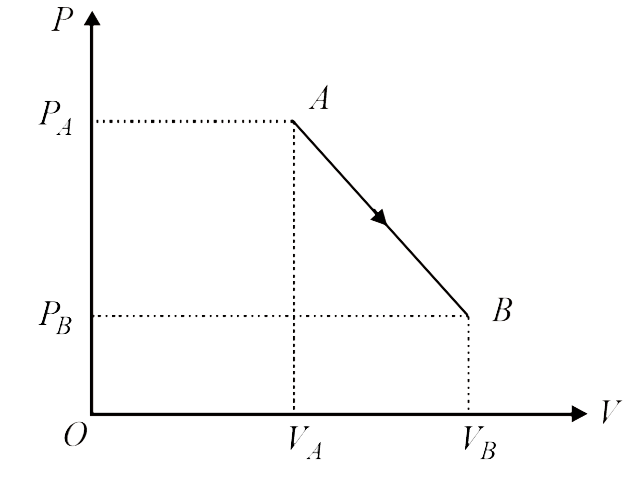A system containing an idealgas was subjected to a number of changes as shown in the P.V.diagram. Temperature at different points are indicated in the diagram.
(i) Name the type of presence at each step.
(ii) What will be the value of ΔUfor the complete process?
(iii) At which point, the number of moles of the gas will be maxmimum ?

(i) AB= isothermal and isobaric expansion
BC=adiabatic expansion ( temperature falls)
CD = isochoric and isothermal
DE = isothermal and isobaric compression
EF = adiabatic compression ( temperature rises)
FA= isothermal and isochoric
(ii) As complete processis cyclic , therefore,ΔU=0
(iii) Process AB is accompanied by increase of volumedue to increase in the number of moles. Process BC is accompanied by increase in volume due to fall of temperature . Process CD is accompanied by fallof pressuredue to decrease in the number of moles. ProcessDE is due to decrease in the number of moles . In process EF, theref will be no change in the number of moles. Process FA is accompanied by increase of pressure due to higher to higher number of moles at A. But as already explained, at B number of moles is greater than that at A . Hence, the number of moles is maximum at point B.
Similar Questions
An ideal gas is taken from point A to the point B, as shown in the P-V diagram, keeping the temperature constant. The work done in the process is

View SolutionOne mole of a monatomic ideal gas is taken through a cycle ABCDA as shown in the P-V diagram. Column II gives the characteristics involved in the cycle. Match them with each of the processes given in Column I.

View Solution
Knowledge Check
An ideal gas is taken from point A to the point B, as shown in the P-V diagram, keeping the temperature constant. The work done in the process is :
 A(PA−PB)(VB−VA)B12(PB−PA)(VB+VA)C12(PB−PA)(VB−VA)D12(PA+PB)(VB−VA)
A(PA−PB)(VB−VA)B12(PB−PA)(VB+VA)C12(PB−PA)(VB−VA)D12(PA+PB)(VB−VA)An ideal gas is taken from point A to the point B, as shown in the P-V diagram, keeping the temperature constant. The work done in the process is :
 A(PA−PB)(VB−VA)B12(PB−PA)(VB+VA)C12(PB−PA)(VB−VA)D12(PA+PB)(VB−VA)
A(PA−PB)(VB−VA)B12(PB−PA)(VB+VA)C12(PB−PA)(VB−VA)D12(PA+PB)(VB−VA)An ideal gas goes from State A to state B via three different process as indicate in the P−V diagram.

If Q2,Q3 indicates the heat absorbed by the gas along the three processes and ΔU1,ΔU2,ΔU3 indicates the change in internal energy along the three processes respectively, thenAQ1>Q2>Q3 and ΔU1=δU2=ΔU3BQ3>Q2>Q1 and ΔU1=ΔU2=ΔU3CQ1=Q2=Q1 and ΔU1>ΔU2>ΔU3DQ3>Q2Q1 and ΔU1>ΔU2>ΔU3
One mole of a monatomic ideal gas is taken through a cycle ABCDA as shown in the P-V diagram. Column II gives the characteristics involved in the cycle. Match them with each of the processes given in Column I.

View Solution(i) Name the type of a diode whose characteristics are shown in Fig.and Fig.
(ii) What does the point P in Fig. represent?
(iii) What does the point P and Q in Fig. represent?
View SolutionOne mole of an ideal Po monoatomic gas is taken 4op through a thermo dynamic process shown in the p−V diagram. The heat supplied to 2po the system in this process is
K×(π+10)p0V0. Determine the value of K

View SolutionOne mole of an ideal gas is taken from state A to state B by three different processes (a) ACB, (b) ADB and (c ) AEB as shown in the P−V diagram. The heat absorbed by the gas is

View SolutionAn ideal gas undergoing a change of state from A to B through four different paths I, II,III and IV as shown in the P-V diagram that lead to the same change of state tyhen the change in internal energy is

View Solution
